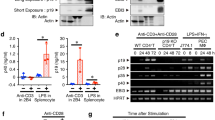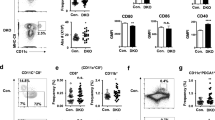Abstract
While there is mounting evidence that interleukin (IL)-23-IL-17 axis plays a critical role in the pathogenesis of various autoimmune diseases, much remains to be elucidated on how IL-23 is induced in the pathological processes. IL-23 is a heterodimer composed of p19 and p40, the latter being shared with IL-12. We previously reported that prostaglandin (PG) E2 promotes CD40-mediated induction of Il23a (p19) expression through its E receptor subtype 4 (EP4) receptor in splenic dendritic cells (DCs). Here, we have analyzed signaling pathways regulating Il23a induction in the cross talk between EP4 and CD40 in bone marrow-derived DCs. We found that PGE2 synergistically induced Il23a transcription with CD40 signaling. An EP4 agonist, but not agonists of EP1, EP2, or EP3, reproduced this action. Stimulation of CD40 with an agonist antibody evoked biphasic induction of Il23a expression, with the early phase peaking at 1 h and the late phase peaking at 12 h and lasting up to 36 h after stimulation, whereas induction by lipopolysaccharide or tumor necrosis factor-α was transient. The early phase induction by CD40 stimulation was absent in DCs derived from Nfkb1-deficient mice, and the late phase induction was eliminated by RNA interference of nuclear factor-kappa B (NF-κB) p100 subunit. Further, cAMP response element-binding protein (CREB) depletion completely eliminated the induction of Il23a by CD40 stimulation. The addition of the EP4 agonist amplified the induction in both phases through the cAMP-protein kinase A (PKA) pathway. These results suggest that Il23a expression in DCs is synergistically triggered by the PG E2-EP4-cAMP-PKA pathway and canonical/non-canonical NF-κB pathways and CREB activated by CD40 stimulation.
This is a preview of subscription content, access via your institution
Access options
Subscribe to this journal
Receive 12 digital issues and online access to articles
$119.00 per year
only $9.92 per issue
Buy this article
- Purchase on Springer Link
- Instant access to full article PDF
Prices may be subject to local taxes which are calculated during checkout





Similar content being viewed by others
References
Langrish CL, Chen Y, Blumenschein WM, Mattson J, Basham B, Sedgwick JD et al. IL-23 drives a pathogenic T cell population that induces autoimmune inflammation. J Exp Med 2005; 201: 233–240.
Sutton CE, Lalor SJ, Sweeney CM, Brereton CF, Lavelle EC, Mills KH . Interleukin-1 and IL-23 induce innate IL-17 production from γδ T cells, amplifying Th17 responses and autoimmunity. Immunity 2009; 31: 331–341.
Spits H, Cupedo T . Innate lymphoid cells: emerging insights in development, lineage relationships, and function. Annu Rev Immunol 2012; 30: 647–675.
Spits H, Artis D, Colonna M, Diefenbach A, Di Santo JP, Eberl G et al. Innate lymphoid cells – a proposal for uniform nomenclature. Nat Rev Immunol 2013; 13: 145–149.
Tait Wojno ED, Artis D . Innate lymphoid cells: balancing immunity, inflammation, and tissue repair in the intestine. Cell Host Microbe 2012; 12: 445–457.
Schmitt J, Rosumeck S, Thomaschewski G, Sporbeck B, Haufe E, Nast A . Efficacy and safety of systemic treatments for moderate-to-severe psoriasis: meta-analysis of randomized controlled trials. Br J Dermatol 2013; 170: 274–303.
Genovese MC, Durez P, Richards HB, Supronik J, Dokoupilova E, Mazurov V et al. Efficacy and safety of secukinumab in patients with rheumatoid arthritis: a phase II, dose-finding, double-blind, randomised, placebo controlled study. Ann Rheum Dis 2013; 72: 863–869.
Baeten D, Baraliakos X, Braun J, Sieper J, Emery P, van der Heijde D et al. Anti-interleukin-17A monoclonal antibody secukinumab in treatment of ankylosing spondylitis: a randomised, double-blind, placebo-controlled trial. Lancet 2013; 382: 1705–1713.
Leonardi CL, Kimball AB, Papp KA, Yeilding N, Guzzo C, Wang Y et al. Efficacy and safety of ustekinumab, a human interleukin-12/23 monoclonal antibody, in patients with psoriasis: 76-week results from a randomised, double-blind, placebo-controlled trial (PHOENIX 1). Lancet 2008; 371: 1665–1674.
Papp KA, Langley RG, Lebwohl M, Krueger GG, Szapary P, Yeilding N et al. Efficacy and safety of ustekinumab, a human interleukin-12/23 monoclonal antibody, in patients with psoriasis: 52-week results from a randomised, double-blind, placebo-controlled trial (PHOENIX 2). Lancet 2008; 371: 1675–1684.
Sandborn WJ, Gasink C, Gao LL, Blank MA, Johanns J, Guzzo C et al. Ustekinumab induction and maintenance therapy in refractory Crohn’s disease. N Engl J Med 2012; 367: 1519–1528.
Kopp T, Riedl E, Bangert C, Bowman EP, Greisenegger E, Horowitz A et al. Clinical improvement in psoriasis with specific targeting of interleukin-23. Nature 2015; 521: 222–226.
Oppmann B, Lesley R, Blom B, Timans JC, Xu Y, Hunte B et al. Novel p19 protein engages IL-12p40 to form a cytokine, IL-23, with biological activities similar as well as distinct from IL-12. Immunity 2000; 13: 715–725.
Tilley SL, Coffman TM, Koller BH . Mixed messages: modulation of inflammation and immune responses by prostaglandins and thromboxanes. J Clin Invest 2001; 108: 15–23.
Narumiya S, Furuyashiki T . Fever, inflammation, pain and beyond: prostanoid receptor research during these 25 years. FASEB J 2011; 25: 813–818.
Hirata T, Narumiya S . Prostanoid receptors. Chem Rev 2011; 111: 6209–6230.
Sheibanie AF, Tadmori I, Jing H, Vassiliou E, Ganea D . Prostaglandin E2 induces IL-23 production in bone marrow-derived dendritic cells. FASEB J 2004; 18: 1318–1320.
Yao C, Sakata D, Esaki Y, Li Y, Matsuoka T, Kuroiwa K et al. Prostaglandin E2-EP4 signaling promotes immune inflammation through Th1 cell differentiation and Th17 cell expansion. Nat Med 2009; 15: 633–640.
Inaba K, Inaba M, Romani N, Aya H, Deguchi M, Ikehara S et al. Generation of large numbers of dendritic cells from mouse bone marrow cultures supplemented with granulocyte/macrophage colony-stimulating factor. J Exp Med 1992; 176: 1693–1702.
Qian X, Ning H, Zhang J, Hoft DF, Stumpo DJ, Blackshear PJ et al. Posttranscriptional regulation of IL-23 expression by IFN-γ through tristetraprolin. J Immunol 2011; 186: 6454–6464.
Song Z, Jin R, Yu S, Rivet JJ, Smyth SS, Nanda A et al. CD40 is essential in the upregulation of TRAF proteins and NF-κB-dependent proinflammatory gene expression after arterial injury. PLoS One 2011; 6: e23239.
Sugimoto Y, Narumiya S . Prostaglandin E receptors. J Biol Chem 2007; 282: 11613–11617.
Mise-Omata S, Kuroda E, Niikura J, Yamashita U, Obata Y, Doi TS . A proximal κB site in the IL-23 p19 promoter is responsible for RelA- and c-Rel-dependent transcription. J Immunol 2007; 179: 6596–6603.
Carmody RJ, Ruan Q, Liou HC, Chen YH . Essential roles of c-Rel in TLR-induced IL-23 p19 gene expression in dendritic cells. J Immunol 2007; 178: 186–191.
Kocieda VP, Adhikary S, Emig F, Yen JH, Toscano MG, Ganea D . Prostaglandin E2-induced IL-23p19 subunit is regulated by cAMP-responsive element-binding protein and C/AATT enhancer-binding protein beta in bone marrow-derived dendritic cells. J Biol Chem 2012; 287: 36922–36935.
Yao C, Hirata T, Soontrapa K, Ma X, Takemori H, Narumiya S . Prostaglandin E2 promotes Th1 differentiation via synergistic amplification of IL-12 signalling by cAMP and PI3-kinase. Nat Commun 2013; 4: 1685.
Nishigaki N, Negishi M, Ichikawa A . Two Gs-coupled prostaglandin E receptor subtypes, EP2 and EP4, differ in desensitization and sensitivity to the metabolic inactivation of the agonist. Mol Pharmacol 1996; 50: 1031–1037.
Poloso NJ, Urquhart P, Nicolaou A, Wang J, Woodward DF . PGE2 differentially regulates monocyte-derived dendritic cell cytokine responses depending on receptor usage (EP2/EP4). Mol Immunol 2013; 54: 284–295.
Kalim KW, Groettrup M . Prostaglandin E2 inhibits IL-23 and IL-12 production by human monocytes through down-regulation of their common p40 subunit. Mol Immunol 2013; 53: 274–282.
Mackey MF, Barth RJ, Jr., Noelle RJ . The role of CD40/CD154 interactions in the priming, differentiation, and effector function of helper and cytotoxic T cells. J Leukoc Biol 1998; 63: 418–428.
Caux C, Massacrier C, Vanbervliet B, Dubois B, Van Kooten C, Durand I et al. Activation of human dendritic cells through CD40 cross-linking. J Exp Med 1994; 180: 1263–1272.
Sallusto F, Lanzavecchia A . Efficient presentation of soluble antigen by cultured human dendritic cells is maintained by granulocyte/macrophage colony-stimulating factor plus interleukin 4 and downregulated by tumor necrosis factor alpha. J Exp Med 1994; 179: 1109–1118.
Esaki Y, Li Y, Sakata D, Yao C, Segi-Nishida E, Matsuoka T et al. Dual roles of PGE2-EP4 signaling in mouse experimental autoimmune encephalomyelitis. Proc Natl Acad Sci USA 2010; 107: 12233–12238.
Chen Q, Muramoto K, Masaaki N, Ding Y, Yang H, Mackey M et al. A novel antagonist of the prostaglandin E2 EP4 receptor inhibits Th1 differentiation and Th17 expansion and is orally active in arthritis models. Br J Pharmacol 2010; 160: 292–310.
Glas J, Seiderer J, Czamara D, Pasciuto G, Diegelmann J, Wetzke M et al. PTGER4 expression-modulating polymorphisms in the 5p13.1 region predispose to Crohn’s disease and affect NF-κB and XBP1 binding sites. PLoS One 2012; 7: e52873.
International Multiple Sclerosis Genetics C, Wellcome Trust Case Control C, Sawcer S, Hellenthal G, Pirinen M, Spencer CC et al. Genetic risk and a primary role for cell-mediated immune mechanisms in multiple sclerosis. Nature 2011; 476: 214–219.
Hinds DA, McMahon G, Kiefer AK, Do CB, Eriksson N, Evans DM et al. A genome-wide association meta-analysis of self-reported allergy identifies shared and allergy-specific susceptibility loci. Nat Genet 2013; 45: 907–911.
Farh KK, Marson A, Zhu J, Kleinewietfeld M, Housley WJ, Beik S et al. Genetic and epigenetic fine mapping of causal autoimmune disease variants. Nature 2015; 518: 337–343.
Acknowledgements
This work was supported by Core Research for Evolutional Science and Technology (CREST) from the Japan Science and Technology Agency (JST) (Shuh Narumiya). We thank Ono Pharmaceutical Co., Ltd., for EP agonists and antagonists, N. Asamoto for technical assistance, and T. Arai and A. Washimi for secretarial assistance. Tomohiro Aoki and Shuh Narumiya were supported by Coordination Fund from JST and Astellas Pharma Inc.
Author information
Authors and Affiliations
Corresponding author
Additional information
Supplementary Information of this article can be found on Cellular & Molecular Immunology website: http://www.nature.com/cmi.
Supplementary information
Rights and permissions
About this article
Cite this article
Ma, X., Aoki, T. & Narumiya, S. Prostaglandin E2-EP4 signaling persistently amplifies CD40-mediated induction of IL-23 p19 expression through canonical and non-canonical NF-κB pathways. Cell Mol Immunol 13, 240–250 (2016). https://doi.org/10.1038/cmi.2015.70
Received:
Revised:
Accepted:
Published:
Issue Date:
DOI: https://doi.org/10.1038/cmi.2015.70
Keywords
This article is cited by
-
Ankylosing spondylitis: an autoimmune or autoinflammatory disease?
Nature Reviews Rheumatology (2021)
-
Anti-IL-23 exerted protective effects on cerebral ischemia–reperfusion injury through JAK2/STAT3 signaling pathway
Molecular Biology Reports (2021)
-
Cytokine “fine tuning” of enthesis tissue homeostasis as a pointer to spondyloarthritis pathogenesis with a focus on relevant TNF and IL-17 targeted therapies
Seminars in Immunopathology (2021)
-
Prostaglandin receptor EP4 expression by Th17 cells is associated with high disease activity in ankylosing spondylitis
Arthritis Research & Therapy (2019)
-
Microenvironmental derived factors modulating dendritic cell function and vaccine efficacy: the effect of prostanoid receptor and nuclear receptor ligands
Cancer Immunology, Immunotherapy (2018)



